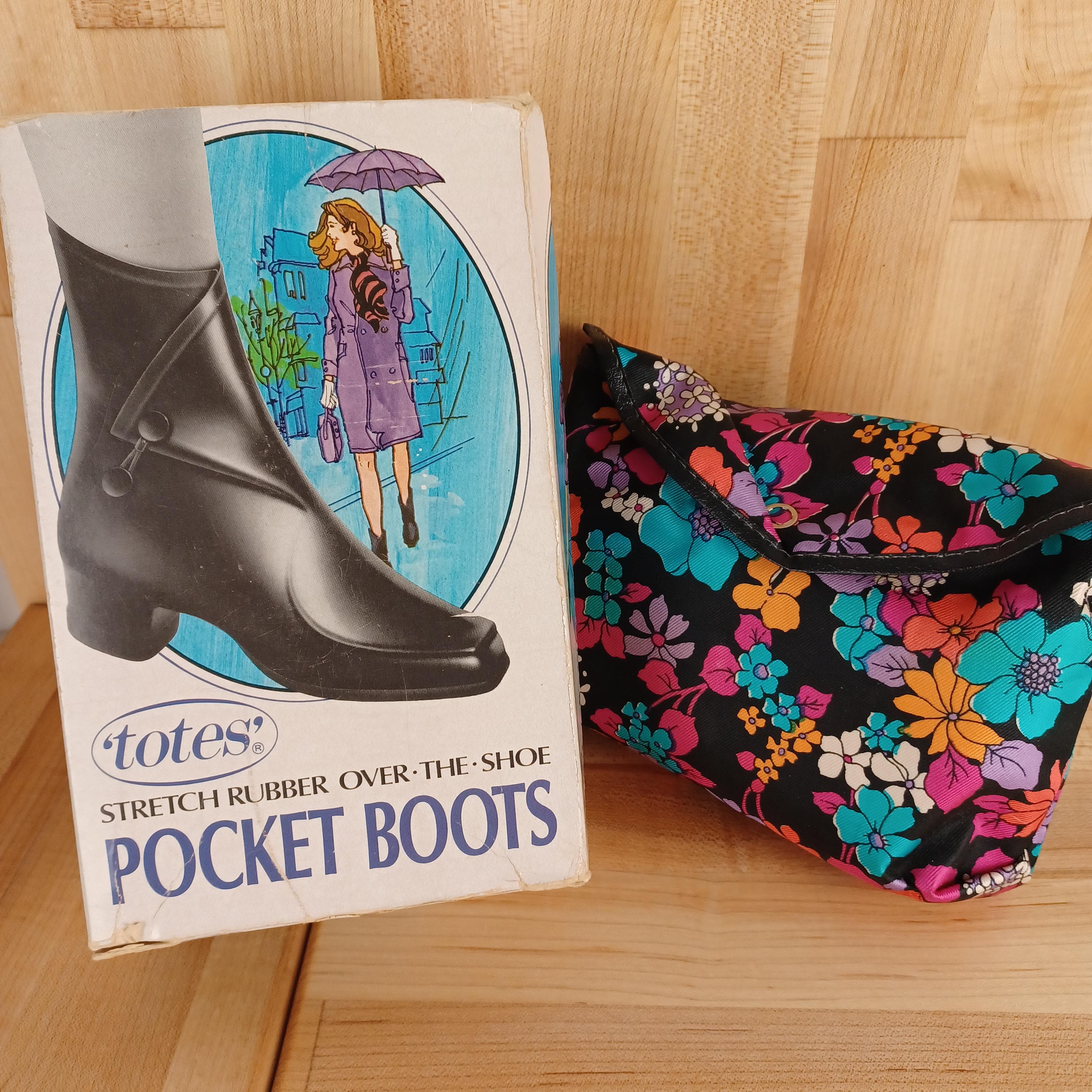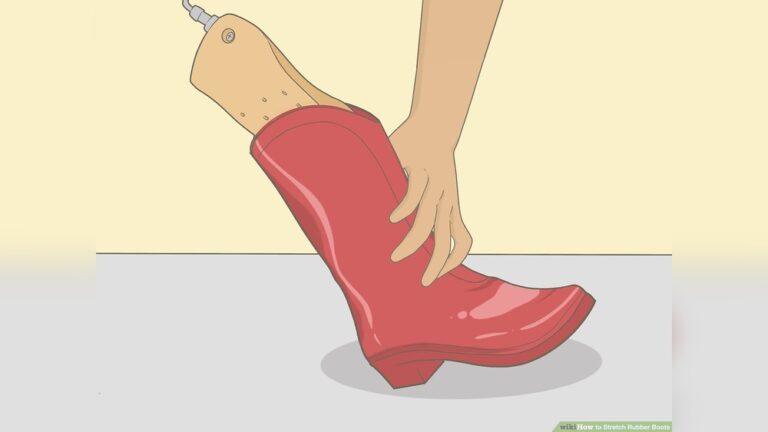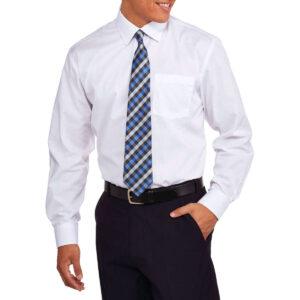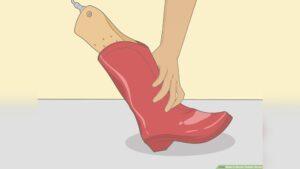Are your rubber rain boots feeling too tight or uncomfortable? If your boots pinch your feet or squeeze your calves, you don’t have to give up on them just yet.
Stretching your rubber rain boots is easier than you think, and with the right techniques, you can create a perfect, comfy fit that lets you enjoy rainy days without pain. Whether your boots are new or just a bit snug, this guide will show you simple, safe ways to stretch them without causing damage.
Keep reading to discover how you can make your rubber rain boots feel like they were made just for you.
Why Rubber Boots Feel Tight
Rubber rain boots often feel tight and uncomfortable at first. Understanding why they feel this way helps you stretch them effectively. The fit issues come from sizing errors and the nature of rubber material. Knowing these points can make wearing your boots more enjoyable.
Common Sizing Issues
Many people buy rubber boots that are too small or narrow. Boots labeled with sizes may not match your exact foot shape. Some brands run smaller or larger than others. Calf width and foot width often differ from standard shoe sizes. This mismatch causes tightness, especially around the toes and calves. Trying boots on late in the day can also affect fit, as feet swell slightly by evening.
Rubber Material Characteristics
Rubber is a stiff material that does not stretch easily at first. It takes time and heat to soften and mold to your feet. New boots feel rigid and resist movement. Rubber contracts when cold and expands with warmth. This property affects how tight the boots feel in different weather. The thickness of the rubber also limits how much the boots can stretch. Over time, wearing boots helps the material become more flexible.
Simple Warmth And Wear Method
The Simple Warmth and Wear Method offers an easy way to stretch rubber rain boots at home. This approach uses gentle heat and natural movement to loosen the rubber. It avoids harsh chemicals or tools that might damage your boots. The method works best for minor tightness and helps make boots more comfortable over time.
Below are three practical steps to try this method effectively. Each step focuses on using warmth and wearing the boots carefully. These steps ensure safe stretching without risking damage.
Using Thick Socks
Start by wearing thick socks to add extra padding. Thick socks create more space inside the boots. They also protect your feet from heat during the warming process. Put on the socks and then slide your boots on over them. The extra bulk helps stretch the rubber gently as you move.
Wearing Boots Indoors
Keep your boots on while walking around your home. Wear them for short periods to let the rubber relax. Moving your feet naturally helps the boots shape to your feet. This step is simple but very effective for mild tightness. Avoid wearing them too long at first to prevent discomfort.
Allowing Natural Stretch
Over time, the rubber will soften and stretch naturally. Heat from your body and movement encourages this process. Repeat wearing the boots with thick socks several times. Patience is key to getting a better fit. This natural stretch reduces pressure and improves comfort without damage.
Hair Dryer Stretching Technique
The Hair Dryer Stretching Technique offers a simple way to loosen tight rubber rain boots. Heat softens the rubber, making it more flexible. This method allows gentle stretching without damaging your boots.
Use this technique carefully. Too much heat can harm the rubber. Follow these steps to stretch your boots safely and effectively.
Preparing With Thick Socks
Start by putting on a pair of thick socks. Thick socks add extra padding inside the boots. They create more space and protect your feet from heat. Wear the socks before putting on your rubber rain boots. This step prepares your boots for gentle stretching.
Applying Heat Safely
Set your hair dryer to medium heat. Hold it a few inches away from the tight areas. Move the dryer constantly to avoid overheating one spot. Heat the boots for about 2 to 3 minutes. The rubber will become softer and more flexible. Avoid using high heat to prevent damage.
Flexing And Walking In Boots
While the boots are warm, flex your feet inside them. Point and wiggle your toes to stretch the rubber. Walk around for 5 to 10 minutes to help the boots mold to your feet. Repeat heating and walking if needed. This process improves comfort and fit over time.

Credit: www.carep.cl
Using A Boot Stretcher
Using a boot stretcher is a simple and effective way to widen rubber rain boots. This tool fits inside the boot and applies gentle pressure. It helps the rubber material stretch without damage. The process is safe and works well for tight spots or overall width expansion. Proper use ensures your boots become more comfortable to wear.
Choosing The Right Stretcher
Select a boot stretcher made for rubber or flexible materials. Some stretchers have adjustable knobs to control the width. Look for one that fits the size of your boots. A two-way stretcher expands both length and width. A one-way stretcher focuses on width only. Pick the type that matches your stretching needs.
Inserting And Adjusting
Insert the stretcher carefully into the boot’s toe area. Turn the knob slowly to widen the stretcher. Apply gentle pressure to avoid tearing the rubber. Check the tight spots and adjust accordingly. You can also use attachments for specific pressure points. Make small adjustments at a time for best results.
Duration For Effective Stretching
Leave the stretcher inside the boot for at least 24 hours. Longer stretching, up to 48 hours, helps for tougher tight spots. Avoid rushing the process to prevent damage. Remove the stretcher and try on the boots to check comfort. Repeat the process if more stretching is needed. Patience leads to better fit and comfort.
Tips For Stretching Calf Area
Stretching the calf area of rubber rain boots can make them more comfortable and easier to wear. The calf is often the tightest part, especially for people with wider calves. Using the right techniques helps avoid damage to the boots while creating a better fit. These tips focus on safe and effective ways to stretch the calf area.
Targeting Wide Calves
Start by identifying the exact tight spot on the calf area. Use thick socks to protect your skin and add slight padding. Put the boots on with the thick socks inside. Walk around gently to help the rubber start to soften and stretch.
Another option is to use a calf-specific boot stretcher. This tool fits inside the boot and applies pressure to widen the calf area evenly. Adjust the stretcher slowly to avoid overstretching or tearing the rubber.
Combining Heat And Stretchers
Heat softens the rubber, making it easier to stretch. Use a hairdryer on medium heat to warm the calf area of the boot. Keep the dryer moving to prevent damage. Once warm, insert the boot stretcher or wear thick socks and put on the boots.
Move your feet and walk around while the rubber cools. This action helps the boots mold to your calf shape. Repeat heating and stretching in small sessions for better results. Avoid high heat to protect the rubber from cracking.

Credit: www.wikihow.com
What To Avoid When Stretching
Stretching rubber rain boots can improve comfort and fit. Avoid damaging your boots by steering clear of certain methods. Knowing what to avoid helps keep your boots in good shape. Some common mistakes can cause permanent damage.
Avoid Freezing Methods
Freezing boots with water inside may seem smart. The water expands and stretches the rubber. But freezing can make the rubber brittle. This leads to cracks and splits. The damage may be invisible at first. Over time, the boots lose their waterproof quality. Avoid this method to protect your boots.
Prevent Overheating
Applying high heat can stretch rubber quickly. Using a hairdryer on high or placing boots near a heater is risky. Excess heat causes the rubber to warp or melt. It changes the shape permanently and weakens the material. Use low or medium heat only. Keep the heat moving to avoid hot spots.
Steering Clear Of Sharp Objects
Some try to stretch boots by inserting sharp items. Needles, knives, or metal tools can puncture rubber. These holes cause leaks and ruin the boots. Rubber can tear easily under pressure. Use smooth, safe tools like boot stretchers designed for this. Avoid sharp objects to keep boots intact.
Maintaining Boot Shape After Stretching
Maintaining the shape of your rubber rain boots after stretching is essential for their longevity and comfort. Without proper care, stretched boots can lose form and become misshapen. Keeping the structure intact helps the boots fit well and look great for a long time.
Simple habits and tools can protect your boots from bending or collapsing. These practices prevent cracks and creases in the rubber, preserving the boots’ original shape. Below are key tips to maintain your boots after stretching.
Proper Storage Tips
Store boots in a cool, dry place away from direct sunlight. Heat and sun can weaken the rubber and cause it to warp. Always clean boots before storing to remove dirt and moisture.
Keep boots upright to avoid folding or creasing. Avoid stacking heavy objects on top of them. Use a boot rack or shelf designed for tall boots to maintain their shape.
Using Boot Trees Or Inserts
Boot trees or inserts help keep rubber boots firm and upright. They fill the inside space and prevent the boots from collapsing. Choose boot trees made from plastic or wood for sturdy support.
Insert boot trees after each wear to maintain the stretched shape. They also help reduce wrinkles and creases on the rubber surface. This simple step extends the life of your boots and keeps them comfortable.

Credit: www.etsy.com
When To Seek Professional Help
Knowing when to seek professional help for stretching rubber rain boots is important. Some boots may not stretch enough with home methods. Professionals have the right tools and skills to handle tough cases. They prevent damage and ensure a perfect fit. Here are key points to consider before deciding to visit a specialist.
Signs Stretching Isn’t Enough
If your boots remain tight after several attempts, they may need expert care. Persistent discomfort or pain when wearing the boots is a clear sign. Visible cracks or damage during stretching show the material is stressed. Boots that lose shape or become misshapen need professional attention. Home stretching cannot fix deep tight spots or structural issues.
Finding A Cobbler Or Specialist
Look for a cobbler who specializes in rubber or waterproof footwear. Local shoe repair shops often offer boot stretching services. Search online or ask for recommendations from friends or family. Describe the boot type and problem clearly to find the right expert. Confirm pricing and turnaround time before leaving your boots. Skilled professionals use proper tools to stretch boots safely and evenly.
Frequently Asked Questions
Is It Possible To Stretch Rubber Boots?
Yes, you can stretch rubber boots using thick socks and a hairdryer on medium heat. Use a boot stretcher for bigger stretches. Avoid extreme heat or freezing, which can damage the rubber. Wearing boots around the house also helps them gradually conform to your feet.
How To Stretch Waterproof Boots?
Stretch waterproof boots by wearing thick socks and warming tight areas with a hairdryer. Use a boot stretcher for more space. Avoid extreme heat or freezing to prevent damage. Gradually wearing boots helps them conform to your feet safely.
How To Expand A Tight Rubber Shoe?
Wear thick socks and put on the rubber shoes. Use a hairdryer on medium heat to warm tight areas. Move the dryer constantly. Flex your feet and walk to stretch. Repeat if needed. Alternatively, use a boot stretcher for significant expansion.
Avoid extreme heat or freezing to prevent damage.
How Long Do Rubber Boots Take To Break In?
Rubber boots usually take 1 to 2 weeks of regular wear to break in comfortably. Wearing thick socks speeds the process. Using a hairdryer on tight spots while flexing your feet also helps soften the rubber. Avoid extreme heat or freezing to prevent damage.
Conclusion
Stretching rubber rain boots is simple and effective with the right methods. Use thick socks and a hairdryer to warm and loosen tight spots. A boot stretcher can help expand boots more significantly. Wearing boots indoors also softens and shapes them naturally.
Always be gentle to avoid damaging the rubber material. With patience, your boots will fit comfortably and protect you well. Enjoy dry feet and a better fit this rainy season.

Madison Clark is a footwear expert and the voice behind MyStyleGrid.com. She specializes in honest shoe reviews, style tips, and practical guides to help readers find the perfect pair for any occasion. With years of experience in blogging and content creation, Madison makes footwear knowledge simple, stylish, and easy to follow.







